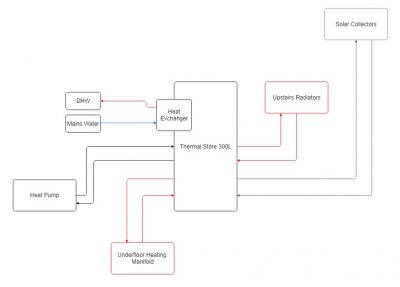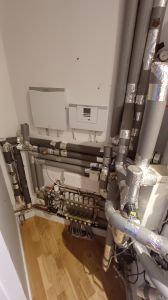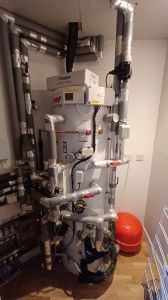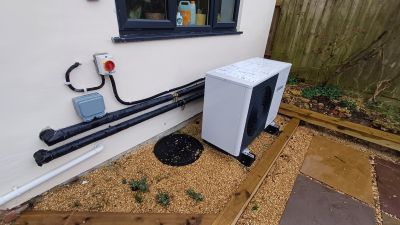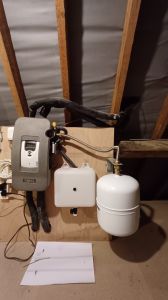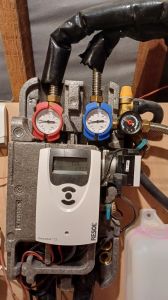Heating and Hot Water Issues with Thermal Store/Heat Pump
Hi,
I've just moved into a new house with a new heating system put in during renovations that hasn't been used yet. From what I can tell it's all based around the 300L Thermal Integration Xcel Heat Bank thermal store connected to which there is a: 3.5kW Vaillant aroTHERM Plus heat pump, solar collectors with a Resol Deltasol CS controller, a plate heat exchanger for DHW, an underfloor heating manifold for the bottom floor, and the upstairs radiator circuit. I have attached photos and a diagram of how I think it's all connected.
Currently, the central heating is working very well with the thermal store temperature staying around 32-37 degrees. However, I cannot get hot water to work as this requires the thermal store to be at around 50 degrees. Trying to maintain this temperature with the central heating running using the heat pump has proved not very efficient and very expensive in electric. So now to get hot water I need to turn off the central heating and let the thermal store heat up, which is a lot quicker without the central heating running, and then I can get loads of hot water.
The only issue I'm having with it is trying to get the hot water and heating working at the same time, as currently I can only get hot water for about 30 mins in the morning when the heating is off, after which the heating comes back on and then the thermal store temp drops back down to below 40 degrees. From what I have read online it would appear that the heating and hot water should be kept separate usually by having the heat pump switch between the heating system and the hot water tank, but I was wondering if anyone had a similar setup that they had managed to get working or had ideas as to what might be wrong?
Any help would be much appreciated.
Heat pumps and thermal stores are bad news, really really bad news.... Who designed this system?
Off grid on the isle of purbeck
2.4kW solar, 15kWh Seplos Mason, Outback power systems 3kW inverter/charger, solid fuel heating with air/air for shoulder months, 10 acres of heathland/woods.
My wife’s house: 1946 3 bed end of terrace in Somerset, ASHP with rads + UFH, triple glazed, retrofit IWI in troublesome rooms, small rear extension.
The first thing that I would question is the size of the heat pump, is it adequate for the heat loss of your home? What are the heat loss calculations for your home?
How much thermal energy does the solar collectors produce?
Assuming that your schematic diagram is correct and the heat pump is adequate to supply both central heating and DHW production, the only way that I can see that the present system could be made to work is as follows.
Operate the heat pump at a fixed Leaving Water Temperature (LWT) of say 50C, to heat the water in the heat store sufficiently to provide hot water.
The water pumps supplying the UFH and radiators from the heat store would need to be controlled by room thermostats. When the room temperature falls below the desired setpoint the water pump takes warm water from the heat store and warms up the UFH and radiators. When the rooms get up to temperature the water pumps stop and the UFH and radiators gradually cool whilst keeping the rooms warm. Whilst the heating system is off the heat pump replaces the now used thermal energy in the heat store, hopefully maintaining the temperature at 50C.
Provided that the heat pump is of adequate size it is possible that the above arrangement could work, though not at optimum efficiency because the heat pump is operating at a higher LWT. When more solar thermal energy is available then of course this will help reduce the loading on the heat pump.
To possibly improve the overall efficiency it would be necessary to install a separate DHW cylinder and a three port diverter valve. This would allow the heat pump to feed either the heat store or the DHW cylinder, but not both at the same time, so the heat pump could be operated at lower LWT when there is not much heating demand.
By keeping the present heat exchanger, but using the output to supply the feed water to the new DHW cylinder it may be possible to use the solar thermal system to provide DHW during the sunnier days.
Sorry to be the bearer of bad news, your system is designed for a high temperature heat source, back boiler, on-off old type gas or oil boiler or biomass. It is not designed, as you have found out, for a low temperature, highly efficient heat pump. This includes the under floor heating manifolds. You will not get hot water unless you run the heat pup at a flow temperature of 55 to 60 Deg C.
I cannot comment on the size of the heat pump, as I do not have the details of your property. However, you do not need a thermal store as you have under floor heating, which is a thermal store. That cylinder can be changed in to a hot water only thermal store, with a good quality deserter valve, you will for a very small amount of work, and unfortunately a lot of rubbish, a well performing system.
Not is all lost.
Posted by: @derek-mThe first thing that I would question is the size of the heat pump, is it adequate for the heat loss of your home? What are the heat loss calculations for your home?
I have got heat loss calculations for the house which say a total of 3.8kW for all rooms, but I think this is ok as the central heating is currently running very well and the cost seems pretty reasonable to me.
Posted by: @derek-mHow much thermal energy does the solar collectors produce?
I don't have any info on the collectors I have that I can find, is there another way to work this out?
Posted by: @derek-mOperate the heat pump at a fixed Leaving Water Temperature (LWT) of say 50C, to heat the water in the heat store sufficiently to provide hot water.
I think this is similar to what I was doing when I asked the heat pump to maintain 50 degrees in the thermal store, but that turned out very expensive.
@heacol would the heat pump be ok for the radiators that I have upstairs, I think they are larger than usual ones to account for lower heat but wondered if they still might need slightly hotter water?
If I was to stick the valve in to separate the heating and hot water, do you think it would be worth trying to link up the solar collectors in any way to supplement the heat pump?
Posted by: @ajwukPosted by: @derek-mThe first thing that I would question is the size of the heat pump, is it adequate for the heat loss of your home? What are the heat loss calculations for your home?
I have got heat loss calculations for the house which say a total of 3.8kW for all rooms, but I think this is ok as the central heating is currently running very well and the cost seems pretty reasonable to me.
Posted by: @derek-mHow much thermal energy does the solar collectors produce?
I don't have any info on the collectors I have that I can find, is there another way to work this out?
Posted by: @derek-mOperate the heat pump at a fixed Leaving Water Temperature (LWT) of say 50C, to heat the water in the heat store sufficiently to provide hot water.
I think this is similar to what I was doing when I asked the heat pump to maintain 50 degrees in the thermal store, but that turned out very expensive.
My suggestion of operating with a LWT of 50C was to help provide hot water without having to make any physical changes to your system.
If you find that method too expensive to operate, then @heacol's suggestion of separating the heating circuits from the heat store and then using the heat store as the supply for DHW heating I do believe would work, but the solar collectors would only assist DHW production and not with central heating.
To fully use the solar collectors for both CH and DHW production would require the addition of a separate DHW cylinder along with the three port diverter valve.
I would suggest that you read the manual for the Resol solar system to see what information the controller may provide.
Hi - I have a GSHP with Thermal store (Lampoassa) and can certainly identify with your problems. If I maintain the store at 50 degrees I always have access to hot water but this is not a particularly efficient set up when heating the house given that the supply temp for UFH needs never to be above 35 degrees. As I understand it the Lampoassa unit has an upper and low part of the store that are held at different temperatures (top high, bottom low) to address this, so that hot water pulls heat from the top, and heating from the bottom -it works to an extent but if I set these at 50/35 the hot water soon runs out.
Anyway, on the positive front I have worked out some mitigation strategies that work v well for us, and may help you:
1. We only run the UFH at night (12-5am) and during the day (12-5pm), when we dont need DHW. During the night electricity is v cheap (EV tariff), so negligible cost, and this blast will warm the house for the morning. We also charge our battery overnight.
2. During the day the external temp is typically higher, the house recieves some solar gain, and on most days I can run the UFH off our solar PVs/battery - again the 5h will heat the house for the evening. With TRVs set at 20 degrees I see occasional min temps of 17 and max of 20 with this regime over the 24h period
3. At 5am (and 5pm) the UFH turns off and the thermal store will come up to 50 degrees and just hold there - hot water is then on demand for the useful times of the day.
To be clear I dont change any settings at the level of the GSHP - its all regulated by my on/off timing controls at the heating manifolds. This strategy defies the logic of 'always on, low and slow' heat pump use but in our case leads to effective and efficient home heating & DHW - I have no idea what my SCOP is (not reported by the unit), but the combination of cheap night tariff, battery, PVs and only running the UFH as described works well for us.
Hope that helps - happy to provide further details if useful
DelT
I often wonder at the competence of the people who design these non-standard systems, without actually thinking about, and specifying, how such a system needs to be operated.
Having a heat store in combination with a solar thermal system is on the face of it a good idea, but does not combine very well with a heat pump and how a heat pump needs to be operated for optimum efficiency.
The designer needs to realise that the heat store cannot also act as the DHW cylinder, whilst also supplying the central heating system.
I should have been a little clearer that my GSHP system has a fully integrated thermal store and is purpose designed to meet heating & DHW. This is a link to the current gen system (I have the earlier 2010 version with much fewer controls
. For sure I can configure it to simultaneously supply heat & hot water to the house, I just find its not so efficient when set up that way
Sorry for taking a while to respond, I've been busy with work.
Posted by: @hughfHeat pumps and thermal stores are bad news, really really bad news.... Who designed this system?
I don't really want to say who it is at the moment as they are currently trying to help me fix it.
I think I might have a very similar style thermal store as my installer said that the thermal store was designed to support both heating and DHW from a heat pump, so a top and bottom temperature section would make sense. Do you know if the temperatures of the sections are usually configurable?
Do you find that the house gets much colder in the evening with your setup? I have definitely found my heat pump has to work a lot harder around 5-6pm, but this is probably because I have my room smartstats bump up from 18 degrees to 21 degrees as that's when I get home from work.
@ajwuk Yes, you can set the temperatures of the upper and lower parts of the tank using the AccumUpperMin and AccumLowermin settings - I set mine at 48 & 43. My GSHP is now 13 years old - the control settings on the system are unbelievably non intuitive, the manual is useless and there are no data/reporting/monitoring features. Its taken me quite some years to really get to grips with it! Re house temperatures I typically find that there is about 4-5h lag between when my UFH manifold is turned on, and when the room temperature adjusts (our house has one big concrete slab with wet UFH). With my strategy of 12-5pm day heating then the house is comfortably warm (20 degrees) from 5-10pm, after which the temp steadily drops by a couple of degrees as we head to night time. My TRVs are just set and left at 20 degrees all day - as I said all my control is at the level of the UFH manifolds (on/off)
- 26 Forums
- 2,342 Topics
- 53 K Posts
- 358 Online
- 6,000 Members
Join Us!
Worth Watching
Latest Posts
-
Controlling Daikin Altherma via P1P2 and Home Assistant
Are there any fellow Daikin Altherma 3M owners who are ...
By weoleyric , 30 minutes ago
-
RE: Configuring third party dongle for Ecodan local control
However, I've found the documentation doesn't work exac...
By F1p , 1 hour ago
-
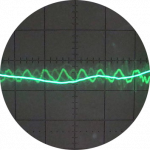
RE: Setback savings - fact or fiction?
@robs — thanks again for your detailed comments. Some r...
By cathodeRay , 2 hours ago
-
RE: Are We Sleepwalking Into Another Race to the Bottom?
The thing that worries me is that this brainless crap i...
By JamesPa , 3 hours ago
-
RE: Free Ecoheat Heat Pump Install
I don't mind thread drift, it's how conversation natura...
By Deltona , 4 hours ago
-

RE: A Smarter Smart Controller from Homely?
@papahuhu I hope you get a swift resolution. Regards, T...
By Toodles , 6 hours ago
-

RE: Poll for Time of Use, tariffs, technology
That’s fine by me too Major, I feel it is a sad reflect...
By Toodles , 7 hours ago
-

Bingo. Sometimes a judiciously placed size 10 bovver bo...
By Majordennisbloodnok , 8 hours ago
-
RE: Mitsubishi Ecodan 11.2kW heat pump with low COP
@ciocoiu-alexandru I can't provide the same level of di...
By Sheriff Fatman , 8 hours ago
-
RE: Octopus Cosy Heat Pump Owners & Discussion Thread
Recently had my follow up with octopus for the vibratio...
By swwils , 9 hours ago
-

The three technical issues I'm considering are: BMS...
By Transparent , 10 hours ago
-
RE: LiFePO4 lithium battery fires and explosions
@transparent Your post may fit better in th...
By Batpred , 10 hours ago
-

RE: British Gas vs Octopus Energy vs Heat Geek vs EDF vs Aira vs OVO vs EON.Next vs Boxt
@jamespawhite, if you could be bothered, you could also...
By Mars , 12 hours ago
-
RE: Commencing on an ASHP Installation Process
I've got a bit of time to draft something today, so the...
By Sheriff Fatman , 1 day ago
-
RE: Help with heat pump sizing
@amin I dont think materially relative to t...
By JamesPa , 1 day ago
-

@majordennisbloodnok I have decided to take the plunge....
By TechnoGeek , 1 day ago
-
RE: Different dT on each radiator?
I cant sorry. Its based on some calculations I did fro...
By JamesPa , 2 days ago
-
RE: Help me keep the faith with my air source heat pump installation
@simonf thats interesting as I’ve noticed my flow and r...
By AdamK , 2 days ago

